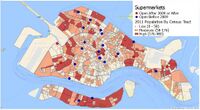Retail Food in Venice
This page contains information regarding retail food in Venice from the Chamber of Commerce and the ShoppMappApp (created by the 2015 Shops Team).
Since 1951, Venice has lost two-thirds of its population. It went from a booming 175,300 in 1951 to only 57,300 in 2015. At the same time, food stores have been declining.

Food Store Closure
Since 1996, around 500 food stores have closed, going from 1,100 to 530 in 2015. That means that 49% of all the food stores that ever existed in Venice have closed since 1924. These can be found on the map that has been included.
Supermarkets
Traditional supermarkets tend to have a chain of production. The producer of the goods usually going through a series of "middlemen" before the goods reach the consumer. This adds costs of transportation, raising the price of the goods. However, since the goods are typically lower quality, and therefore less expensive, this approach is a cost-effective business model. While these small food stores have been closing, supermarkets, on the other hand, have grown since the mid-90s. In 1994, there were only 5 supermarkets located in the historic center of Venice, while today 24 are in existence. Among these, 7 have opened since 2009. These newer supermarkets are popping up in areas with low residential population, indicating that the tourist population is what is sustaining these supermarkets. As was just mentioned, there are a variety of places to purchase food in Venice. Supermarkets are present in Venice (the historic center and surrounding islands), totaling 27 stores in all, which is a large amount for a population of less than 60,000 in a concentrated area of 414 km². The dominant grocery stores in Venice include Coop, Punto Simply, and Conad. These markets sell a variety of food products at wholesale prices, but are imported from farther locations and do not meet a high-quality standard.

It is also worth noting that these newer supermarkets have been appearing along commuting routes and near boat stops.
References
- Census tracts. (n.d.). Retrieved November 10, 2016, from http://www.venipedia.org/wiki/index.php?title=Census_tracts
- Chamber of Commerce
- LaRovere, R., Sawin, J., Gandoomi, K., and Sherifi, E. Evaluating Changes in the Venetian Retail Sector and Managing its Use of Public Space. (Undergraduate Interactive Qualifying Project No. E-project-122215-094837). Retrieved from Worcester Polytechnic Institute Electronic Projects Collection: http://www.wpi.edu/Pubs/E-projecthttp://www.wpi.edu/Pubs/E-project/Available/E-project-122215-094837/unrestricted/VE15SHOPS_PAPER.pdf
/Scanned/05C008I.pdf